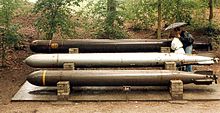Mark 18 torpedo
| Mark 18 torpedo | |
|---|---|
| Produced | 1943-1945[2] |
| No. built | 9000[2] |
| Specifications | |
| Mass | 3,154 lb (1,431 kg)[1] |
| Length | 245 in (6.2 m)[1] |
| Diameter | 21 in (530 mm)[1] |
| Effective firing range | 4,000 yd (3,700 m)[1] |
| Warhead | Mod 0 Torpex, Mod 2 Torpex/HBX,[3] Mod 3, HBX[1] |
| Warhead weight | Mod 0 600 lb (272 kg), Mod 2 595 lb (270 kg),[3] Mod 3 575 lb (261 kg)[1] |
Detonation mechanism | Mk 8 contact exploder, Mk 9 contact/influence exploder[1] |
| Engine | Electric motor[1] |
| Maximum speed | 29 kn (54 km/h)[1] |
Guidance system | Gyroscope[1] |
Launch platform | Submarines[1] |
The Mark 18 torpedo was an electric
Development


The Mark 18 was built in competition with the
In 1942, several German
Westinghouse quickly decided to copy the G7e, and "went to work with a speed and fervor that was dazzling"[6] (certainly in comparison to NTS's languid pace). Design was complete by mid-April, and a contract for 2,000 Mark 18s, 2,020 warheads, 543 exercise heads (for training shots), tools, spares, and workshop gear was issued 2 May. The first test models were delivered just 15 weeks after Westinghouse started work[5] and the Mark 18 was promised to the Submarine Force by summer 1942.[7]
Problems

The batteries (provided by
Deployment
The first submarines to use Mark 18s (still not perfected) were
Characteristics
The Mark 18 did not produce a wake of bubbles or turbine exhaust pointing back to the submarine firing it - a major advantage in daytime engagements. The torpedo also lacked the depth-keeping and exploder problems that had plagued the Mark 14. The disadvantages were the low speed compared to the Mark 14's 45 kn (83 km/h; 52 mph), the need to regularly withdraw the torpedoes from their tubes for recharging, sensitivity of the batteries to water temperature,[16] and onerous maintenance procedures. The Mark 18 shared one major flaw with the Mark 14: it had no protection against circular runs, a defect which claimed Tang for certain, and possibly other U.S. submarines, as well; "Donc" Donaho's Flying Fish was nearly sunk by a trial model in October 1943.[17]
Some 30% of torpedoes fired by U.S. submarines in the Pacific War were Mark 18s.[18]
The design was dropped from service in 1950 in favor of faster and more reliable later types.[19]
The Mark 18 was 20 feet (6.1 m) long, weighed 3,154 pounds (1,431 kg), had a warhead of 575 pounds (261 kg) of Torpex with a contact exploder, and had a speed of 29 knots (54 km/h; 33 mph) and a maximum range of 4,000 yards (3,700 m). By July 1944, an improved version had appeared.[4][20]
See also
- American 21 inch torpedo
References
- ^ a b Jolie, E.W. (15 September 1978). "A Brief History of U.S. Navy Torpedo Development". Retrieved 5 June 2013.
- ^ ISBN 978-1-59114-688-9
- ^ a b U.S. Navy Torpedo Mark 18 (Electric), Description, Adjustment, Care, and Operation. United States Navy. April 1943.
- ^ a b c d e f g h i Blair, Clay Jr. (1976), Silent Victory, New York: Bantam, p. 280
- ^ Blair 1976, p. 281
- ^ a b Blair 1976, p. 402
- ^ a b Blair 1976, p. 403
- ^ Blair 1976, pp. 402, 469
- ^ Blair 1976, p. 479
- ^ Blair 1976, p. 404 & passim
- ^ Blair 1976, p. 510
- ^ Blair 1976, p. 939
- ^ Blair 1976, p. 511. The Mark 14, at least, would leave the tube correctly.
- ^ Blair 1976, p. 511
- ^ Blair 1976, p. 509
- ^ Blair 1976, pp. 513, 939
- ^ Blair 1976, 694fn and p. 818
- ^ USA Torpedoes of World War II
- ^ Blair 1976, 694fn
Bibliography
- Grulich, Fred (2003). "Loss of the Battleship Royal Oak". Warship International. XL (2): 133. ISSN 0043-0374. discusses how the Mk 18 was based on the G7e
External links
